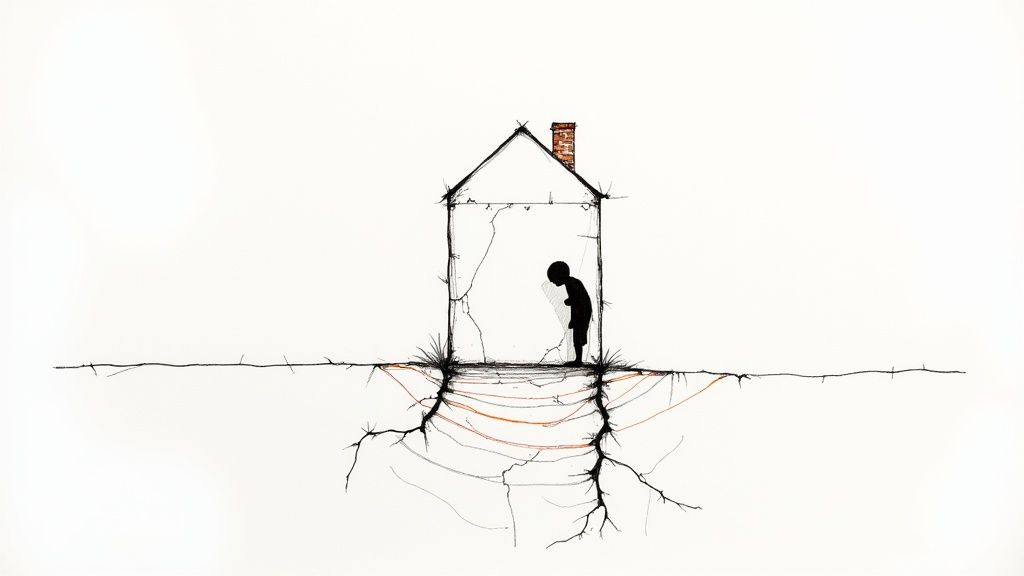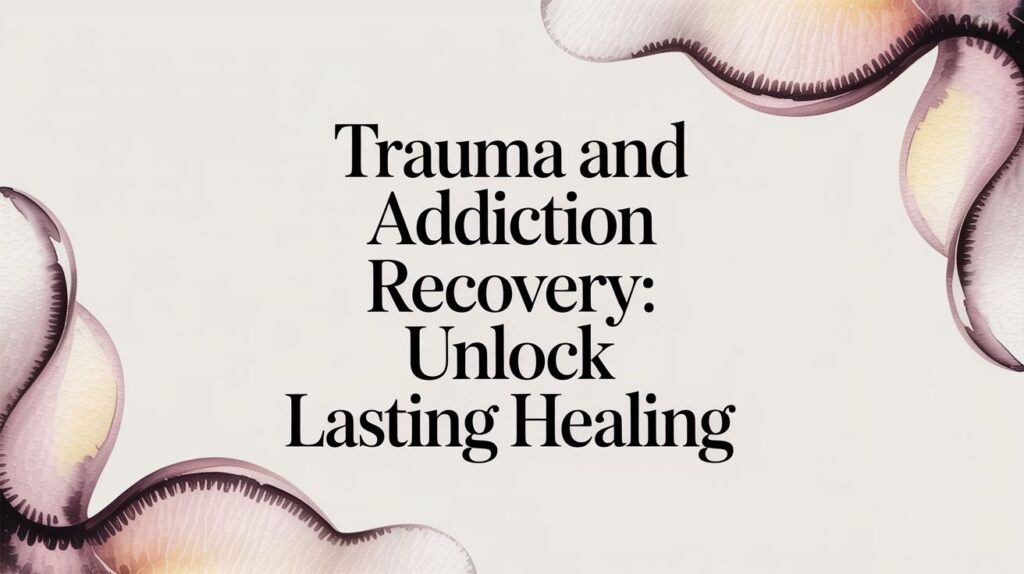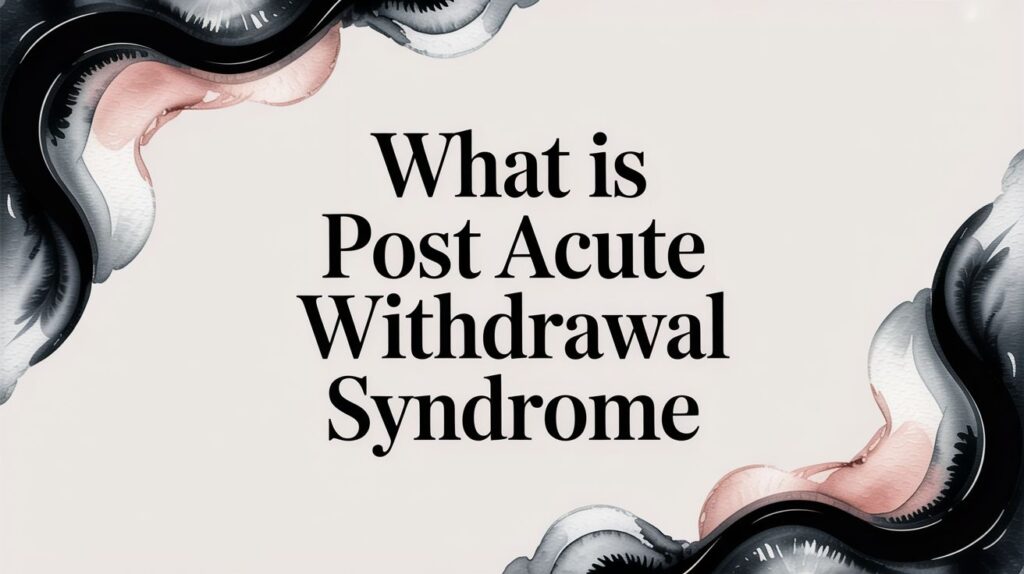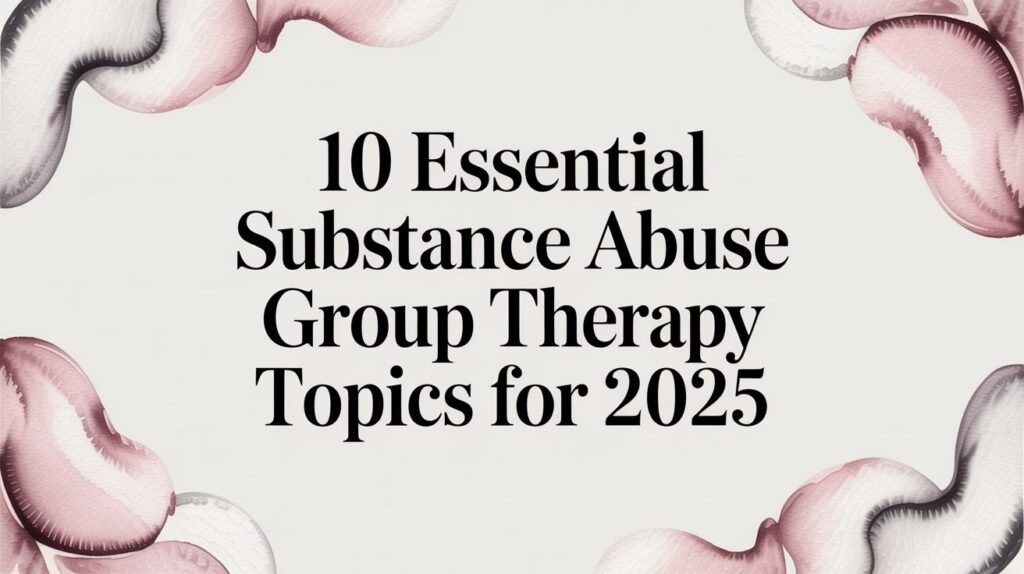When you're trying to help someone heal from addiction, it’s easy to focus on the behavior you can see—the substance use. But that's often just the tip of the iceberg. True, lasting recovery isn't just about stopping a behavior; it's about digging deeper to heal the invisible wounds that fuel it in the first place.
For so many people, addiction is a coping mechanism, a way to survive unresolved traumatic experiences. This means recovery is less about quitting and more about building a new foundation for a life that isn't weighed down by the past.
Understanding the Roots of Trauma and Addiction

To really grasp how trauma and addiction are linked, picture a house with a cracked foundation. The addiction is what you see on the surface: the substance use, the broken relationships, maybe a lost job. These are the cracks spreading across the walls. But the real problem—the thing causing all the damage—is the unstable, fractured ground underneath. That's the unresolved trauma.
You can patch the cracks in the walls, but it's a temporary fix. As long as the foundation is broken, the house will never be sound.
This gets to the heart of why treating addiction without addressing trauma often fails. It’s like painting over a crumbling wall. It might look better for a little while, but the underlying issue will always cause new problems to appear. This connection isn't just a coincidence; it's a deeply ingrained response wired into our brains and bodies.
How Trauma Rewires the Brain for Survival
When someone goes through a traumatic event, their brain's survival system kicks into high gear. The amygdala, which acts like the brain's smoke detector, becomes hyper-vigilant and starts scanning for threats everywhere, all the time. This constant state of high alert literally rewires neural pathways, making it incredibly difficult to regulate emotions, control impulses, or ever feel truly safe.
Living in a constant state of internal emergency is exhausting and painful. It shows up in disruptive ways that can take over a person's life:
- Intrusive Memories: Unwanted flashbacks or nightmares that make the past feel like it's happening right now.
- Emotional Numbness: A sense of being detached from yourself and others, like you're just watching your own life from a distance.
- Hyperarousal: Feeling constantly on edge—anxious, irritable, startling easily, and never able to fully relax.
When you're trapped in that state, substances can feel like a lifeline. They offer a way to silence the internal alarms, numb the pain, or just find a single moment of peace. The relief is instant, but it’s a dangerous trade-off that only digs the hole deeper over time.
Addiction often isn't the primary problem but a symptom of a deeper wound. It’s a person’s attempt to solve the overwhelming problem of emotional pain, and when you look at it that way, it makes perfect sense.
Shifting from a Moral Issue to a Medical One
Once you see this connection, it becomes impossible to view addiction as a moral failing or a simple lack of willpower. It's a coping response to profound, unresolved pain. This is precisely why a trauma-informed approach to trauma and addiction recovery isn't just a "nice-to-have"—it's absolutely essential for anyone to have a real shot at healing.
The numbers tell the same story. Research shows that up to 66% of people in treatment for substance abuse have a history of trauma. Looking at the broader population, as many as 75% of individuals have experienced a highly stressful event that could lead to Post-Traumatic Stress Disorder (PTSD). You can find more data on this connection over at drugabusestatistics.org.
This data isn't just academic; it's a clear call to action. We have to treat the visible cracks and the fractured foundation at the same time. By acknowledging the trauma, we open up a path to a recovery that isn't just about staying sober, but about rebuilding a whole life on solid ground.
Why Treating Addiction Alone Isn't Enough
Trying to treat addiction without addressing the trauma underneath is like bailing water out of a boat without plugging the hole. You might make some headway for a bit, but the real issue guarantees you’ll eventually find yourself sinking again. When trauma is driving the bus, it acts as a hidden relapse trigger—a landmine just waiting for a moment of stress, conflict, or even unexpected joy to detonate.
For someone in early recovery, this is incredibly confusing and demoralizing. They can follow all the rules, hit every meeting, and still feel that powerful magnetic pull back toward their substance of choice. This isn't a failure of willpower; it’s the untreated wound demanding to be soothed. The only "solution" the brain has learned for that specific pain is the one that comes from a bottle or a pill.
Recognizing the Need for Integrated Care
So how can you tell if unresolved trauma is sabotaging someone's recovery? The signs are often subtle, easily mistaken as just part of the addiction itself. Spotting them is the first real step toward getting the right kind of help.
Look for patterns that just won't quit, even after the substance use has stopped:
- Intense Emotional Reactions: Seemingly small setbacks or a bit of criticism triggers an overwhelming wave of panic, anger, or despair.
- Persistent Detachment: An ongoing feeling of being numb or disconnected from loved ones and life, even when sober.
- Chronic Shame and Self-Blame: A deep-seated belief of being fundamentally "broken" or unworthy that sobriety just can't seem to touch.
These aren't just leftover symptoms of addiction; they are the echoes of trauma. When these signs are present, it’s a clear signal that a deeper, more specialized approach to trauma and addiction recovery is needed for healing to actually stick.
A person can be completely abstinent but still live in a state of constant internal chaos. Until the trauma is addressed, they are not truly in recovery; they are just white-knuckling sobriety while the real storm rages inside.
The Professional Assessment Process
This is exactly why a thorough, thoughtful assessment process is so critical. A facility that specializes in integrated care won’t just ask, "What are you using?" They'll also ask, "What happened to you?" Professionals use specific screening tools designed to identify co-occurring disorders like PTSD, anxiety, and depression right alongside the substance use disorder.
This process isn't something to be afraid of—it's an act of discovery. It gives the treatment team the full picture, allowing them to create a personalized plan that addresses both the symptoms (the addiction) and the source (the trauma) at the same time.
Knowing this empowers you. You can confidently ask any treatment provider, "How do you screen for and treat co-occurring trauma?" That one question can help you find a program offering a real path to sustainable healing, not just another temporary fix.
How Integrated Therapies Heal Body and Mind
To truly heal the deep-seated link between trauma and addiction, we have to go beyond just managing sobriety. It’s not enough to simply white-knuckle through cravings. Real recovery requires a toolkit designed to work on both the mind and the body, getting to the root of the pain while building practical skills for the future.
Think of your nervous system like a car that’s been stuck with the accelerator floored for years after a crash. Integrated therapies are what help you gently apply the brakes, learn how to drive again, and finally feel in control behind the wheel.
EMDR: Refiling Traumatic Memories
Eye Movement Desensitization and Reprocessing (EMDR) is a powerful, targeted therapy that helps the brain finally process traumatic memories that have gotten “stuck.” Imagine a librarian has a terrifying book that was never properly filed. Instead of being safely on a shelf, it’s left wide open on the main desk, causing chaos and distress for everyone in the library.
EMDR acts like that skilled librarian. Using bilateral stimulation (like side-to-side eye movements or tapping), it guides your brain to correctly process and file away the memory. The memory doesn't just vanish—that's not the goal. Instead, it gets put in its proper place. It becomes part of your story, not a terrifying event that constantly hijacks your present.
CBT: Becoming a Thought Detective
Cognitive Behavioral Therapy (CBT) works on a simple but profound principle: our thoughts, feelings, and behaviors are all connected. For someone grappling with trauma and addiction, distorted thought patterns can create a vicious cycle. Thoughts like "I'm worthless" or "I'll never be safe" become powerful triggers for cravings and relapse.
CBT trains you to become a detective of your own mind. It gives you the tools to:
- Identify the automatic negative thoughts that fuel both trauma responses and substance use.
- Challenge these thoughts by looking for hard evidence. Are they really 100% true?
- Reframe them into more balanced, realistic perspectives.
By learning to change your thinking, you gain the power to change your feelings and, ultimately, your actions. You learn to interrupt the cycle before it even starts, responding to triggers with clarity instead of compulsion.
DBT: Building Essential Life Skills
If CBT is about changing your thoughts, Dialectical Behavior Therapy (DBT) is about learning to manage your emotions and get through crisis moments without making things worse. For anyone whose trauma has left them with intense, overwhelming emotional swings, DBT is like a practical, hands-on class for emotional survival.
DBT teaches that you can accept yourself and your intense emotions exactly as they are, while also committing to changing your destructive behaviors. This balance of acceptance and change is the key to building a life worth living.
It focuses on four crucial skill sets:
- Mindfulness: Staying present in the moment without judging yourself.
- Distress Tolerance: Getting through a crisis without turning to substances to escape.
- Emotion Regulation: Understanding and managing intense feelings in a healthy way.
- Interpersonal Effectiveness: Building stronger relationships and setting firm boundaries.
The Stabilizing Role of Medication
Sometimes, the nervous system is so overwhelmed by trauma that it’s nearly impossible to even begin the deep work of therapy. The "fight-or-flight" response is stuck in the "on" position, making it hard to think clearly, feel safe, or regulate emotions. In these cases, medication management can be a crucial stabilizing force.
Medications can help calm the internal storm, reducing the crushing symptoms of anxiety, depression, or PTSD. This creates the mental and emotional breathing room needed for therapies like EMDR, CBT, and DBT to really take hold. It’s not a standalone fix, but a supportive tool that makes the deeper healing of trauma and addiction recovery possible.
The global need for these kinds of integrated approaches is staggering. The World Health Organization reports that the harmful use of alcohol and drugs leads to over 3 million deaths worldwide each year. In the United States, 46.3 million people had a substance use disorder in 2021, but a shocking 93.7% of them did not receive any treatment. That gap is even wider when unresolved trauma is part of the picture. You can discover more insights about these alarming addiction statistics on TherapyRoute.com.
As you heal your mind and body, remember that quality rest is a cornerstone of recovery. A calm, restorative sleep environment can make a world of difference. To learn more, check out this guide to healthier, greener sleep through organic bedding.
Navigating Your Path Through Outpatient Recovery
Stepping down from a highly structured treatment program back into the rhythms of daily life can feel like walking a tightrope. Outpatient care is the safety net that makes this transition not just possible, but successful. Think of it as scaffolding around a building under repair; as you rebuild your life, the external support is gradually removed, but only when you're strong enough to stand on your own.
This step-down approach is at the heart of modern trauma and addiction recovery. It’s not an abrupt leap of faith but a carefully managed process of re-engaging with the world. It allows you to practice new coping skills in real-world settings while staying connected to your therapeutic team, preventing overwhelm as you learn to balance work, family, and healing.
Understanding the Levels of Support
Outpatient programs aren’t one-size-fits-all. They are designed to meet you exactly where you are in your recovery, offering different levels of intensity and time commitment. This flexibility is what makes recovery work alongside your life, not in place of it.
The main levels you'll encounter are:
- Partial Hospitalization Program (PHP): This is the most intensive form of outpatient care, often the immediate next step after a residential stay. It typically involves several hours of therapy, five days a week, providing a strong container of support as you start navigating daily triggers again.
- Intensive Outpatient Program (IOP): Offering more flexibility, an IOP usually requires a few hours of participation, several days a week. This level is perfect for those who are stable enough to handle work or school but still need consistent, structured therapeutic support.
- Supportive Outpatient Program (SOP): This is the final step in the scaffolding analogy. An SOP involves less frequent check-ins, maybe just once a week, to help you maintain progress, troubleshoot challenges, and reinforce the healthy habits you've built.
A Comparison of Outpatient Program Levels
To make the differences clearer, here’s a simple breakdown of how these programs compare in terms of time and focus. This table can help you visualize the step-down process and understand where you or a loved one might fit best.
| Program Level | Weekly Time Commitment | Focus of Treatment |
|---|---|---|
| Partial Hospitalization (PHP) | 20-25+ hours over 5 days | Intensive skill-building and stabilization; a direct alternative to residential care. |
| Intensive Outpatient (IOP) | 9-15 hours over 3-5 days | Balancing structured therapy with reintegration into work, school, and family life. |
| Supportive Outpatient (SOP) | 1-3 hours over 1-2 days | Relapse prevention, long-term maintenance, and strengthening community support. |
Each level serves a distinct purpose, ensuring that the support you receive is always aligned with your current needs, giving you the best shot at lasting recovery.
Practicing Recovery in Real Time
The true power of outpatient treatment is its immediacy. You don’t have to wait to apply what you’re learning in a therapy session. You might discuss a conflict with your boss in a morning group and use the communication skills you just practiced that very same afternoon at work.
This real-time application is what makes new behaviors stick. It turns theoretical knowledge into lived experience, proving to yourself that you can handle life’s curveballs without falling back on old, destructive coping mechanisms. Each small success builds momentum, strengthening your resilience for the long haul.
The goal of outpatient care is not just to prevent relapse, but to build a life so fulfilling that substances no longer have a place in it. It’s about moving from surviving to thriving.
The recovery journey is a hopeful one, though it comes with challenges. In the United States, of the 30.5 million adults who ever felt they had a substance use problem, an encouraging 73.1% now consider themselves to be in recovery. Still, a treatment gap remains, as only 23.6% of those who needed substance use treatment in the past year actually got it. You can find more insights on the current landscape of addiction recovery on pinnaclerecovery.org.
These evidence-based therapies are the engine of healing in outpatient care.

Each approach—EMDR, CBT, and DBT—offers a distinct set of tools. Together, they help you process traumatic memories, rewire harmful thought patterns, and build the emotional skills needed for a stable, lasting recovery.
Building Your Personal Relapse Prevention Toolkit

Real success in trauma and addiction recovery isn’t just about understanding the past; it’s about actively building a different future. This is where we move from therapy concepts to a tangible toolkit you can grab in the heat of a difficult moment.
Think of it like assembling your own emotional first-aid kit. It’s filled with practical, go-to strategies for managing triggers, cravings, and the inevitable curveballs life throws your way. Instead of feeling ambushed and helpless, you’ll have a set of proven actions that protect your sobriety and reinforce your healing.
The goal? To make healthy coping your new automatic response.
Mastering Essential Life Skills
Lasting recovery is built on a foundation of new, constructive habits. These skills are designed to manage the sudden waves of anxiety or the sharp memories that trauma can leave behind, giving you healthy outlets where substances once served as a dangerous escape.
Your toolkit should have a variety of strategies for different challenges:
Grounding Techniques: When anxiety spikes or a flashback feels like it's taking over, grounding yanks you back into the present moment. The “5-4-3-2-1” method is a classic for a reason: name five things you can see, four you can feel, three you can hear, two you can smell, and one you can taste. It immediately pulls your focus away from internal chaos and back to the safety of your surroundings.
Constructive Emotional Expression: Trauma and addiction often teach us to bottle up difficult emotions. Learning to let them out constructively is a game-changer. This could be anything from free-form journaling to using "I feel" statements with loved ones or channeling that raw energy into painting, music, or another creative outlet.
Healthy Boundary Setting: Protecting your energy and sobriety often comes down to setting firm boundaries. This doesn’t have to be confrontational. It can be as simple as practicing scripts like, "I appreciate the invite, but I can't make it," or "I'm not in a space to talk about that right now." Boundaries aren’t about pushing people away; they're about creating a safe space for your own well-being. Building self-discipline is key to making these stick, and there are some great actionable self-discipline techniques that can help reinforce these new habits.
Creating Your Personalized Relapse Prevention Plan
A relapse prevention plan is your strategic roadmap for navigating recovery. It’s a real, written document you create with your therapist that outlines exactly what to do when you feel vulnerable. It turns good intentions into concrete, actionable steps.
Your relapse prevention plan is your personal recovery playbook. It prepares you for high-risk situations by defining your triggers, outlining your coping strategies, and identifying your support system before a crisis hits.
Your plan needs to be detailed and specific, covering several key areas:
Identify High-Risk Situations: Get granular. Make a list of the specific people, places, feelings, or events that trigger cravings or traumatic stress.
Build a Sober Support Network: Write down the actual names and numbers of trusted friends, family members, sponsors, or therapists you can call at a moment's notice.
Schedule Positive Activities: Don't leave your free time to chance. Proactively fill your schedule with healthy, enjoyable activities that give you a sense of purpose and joy, whether it's hiking, volunteering, or learning a new skill.
Manage Withdrawal Symptoms: Post-acute withdrawal can be a massive trigger, and knowing how to handle its symptoms is critical. Understanding what is post-acute withdrawal syndrome is a vital part of your plan, giving you the knowledge to navigate this challenging but temporary phase.
The Overlooked Role of Family in the Healing Process
When someone is struggling with addiction and trauma, it's easy to focus on them as an individual. But the truth is, recovery rarely happens in a vacuum. It unfolds right in the middle of a family, a web of relationships where everyone is affected. Trauma and addiction don’t just hit one person—they send shockwaves through the entire family system, and loved ones play a massive role in whether healing takes root or stalls out.
Think of it like a ripple effect. The initial splash disrupts everything. Communication gets tangled, trust shatters, and unhealthy dynamics like codependency start to grow. Family members, driven by love and fear, often find themselves trapped in a cycle of enabling. They might cover for missed appointments or offer financial bailouts, hoping to help, but accidentally shielding their loved one from the very consequences that could spark the motivation for real change.
Shifting from Enabling to Empowering
One of the hardest but most powerful shifts a family can make is moving from enabling to empowering. This isn't about being harsh; it's about offering the kind of tough, structured love that fosters genuine recovery. It means trading well-intentioned "help" that unintentionally fuels the problem for healthy boundaries that protect everyone.
Support that truly empowers recovery looks like this:
- Setting Clear Boundaries: This is about defining what you will and will not do. It’s saying "no" to giving money you know will go to substances or refusing to make excuses for them at work. These aren't punishments; they are guardrails for a healthier relationship.
- Encouraging Accountability: Letting someone experience the natural outcomes of their choices is vital. It’s not about watching them fail, but allowing them to see the real-world impact of their actions, which is often the catalyst for wanting to change.
- Celebrating Progress: The journey is long, and small wins matter. Acknowledging the effort to attend a meeting or be honest about a craving provides the encouragement needed to keep going. It reinforces that their hard work is seen and valued.
Family involvement isn't about "fixing" the person struggling. It’s about healing the entire family system. When loved ones learn healthier ways to communicate and set boundaries, they build a stable, supportive environment that makes lasting recovery possible for everyone involved.
Rebuilding Trust and Finding Your Own Support
Putting the pieces of a family back together is a team effort, and it almost always requires professional guidance. Family therapy sessions create a safe, neutral space to untangle years of hurt, miscommunication, and broken promises. In these sessions, everyone gets a voice, learning how to express their feelings and needs in a way that can actually be heard. It's slow, painstaking work, but it's how trust begins to regrow.
Just as importantly, family members need to find their own support. They’ve been through their own trauma watching a loved one suffer. Resources like Al-Anon and Nar-Anon are incredible, offering a community of people who just get it. Sharing experiences with others who have walked the same path provides a lifeline for processing the pain, fear, and frustration. By taking care of themselves, family members become stronger, more grounded allies in the long road of trauma and addiction recovery.
Your Questions About Recovery, Answered
Deciding to face trauma and addiction head-on brings up a lot of questions—practical, emotional, and everything in between. It’s completely normal. Getting clear, honest answers is the first step toward feeling confident and ready for the path ahead. Here, we’ll tackle some of the most common questions we hear from people just starting their journey.
How Do I Know if Trauma Is Driving My Addiction?
While only a professional can give you a formal diagnosis, you can often see the connection yourself. A huge red flag is when you find yourself using substances specifically to push away painful memories, numb your emotions, or silence racing, intrusive thoughts.
Another telltale sign is noticing that moments of intense anxiety, panic, or being "triggered" almost always create an immediate, overwhelming urge to use. If you can draw a straight line from a reminder of a past event to picking up a drink or a drug, that’s a powerful clue that they’re intertwined. An expert assessment at a center that understands co-occurring disorders can confirm the link and build a treatment plan that addresses the real problem.
Can I Just Treat the Addiction First and Trauma Later?
This is a common thought, but it almost never leads to lasting sobriety. Why? Because the unresolved trauma is often the very thing fueling the addiction. When you only treat the symptom (the substance use), you leave the root cause completely untouched. This makes you incredibly vulnerable the next time you face stress, a conflict, or an emotional trigger.
Treating addiction without addressing the underlying trauma is like repeatedly patching a leaky roof without fixing the hole. True recovery requires repairing the source of the damage to ensure a stable, lasting foundation for sobriety.
An integrated approach that addresses both issues at the same time gives you a much, much higher chance of building a recovery that lasts.
What Is the Main Benefit of Outpatient Care?
The single greatest advantage of an outpatient program is that you get to heal within the context of your actual life. Instead of pausing everything, you can immediately practice the new coping skills you learn in therapy to handle real challenges at home, work, or school—all while having consistent professional support to fall back on.
This approach lets you maintain your responsibilities and stay connected to your support system. It builds a natural bridge between the therapeutic environment and your daily world, making the transition into long-term recovery smoother and far more sustainable.
At Altura Recovery, we know that healing from trauma and addiction requires a path that actually fits your life. Our flexible outpatient programs are designed to provide expert, integrated care while you continue to manage your work, family, and personal commitments. Begin building your foundation for real healing by exploring our services at Altura Recovery.




![Top 12 Dual Diagnosis Treatment Centers Texas [2025 Guide]](https://alturarecovery.com/wp-content/uploads/2025/11/thumbnail-21-1024x574.jpg)


